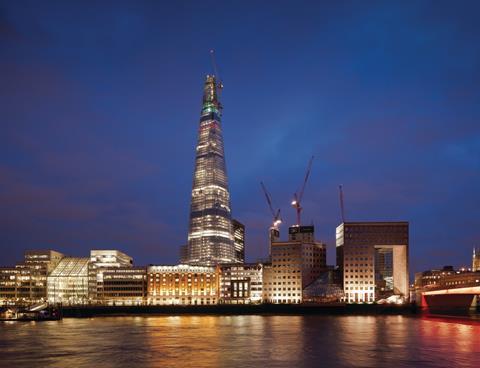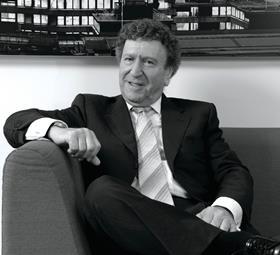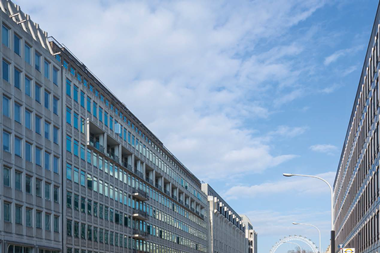Irvine Sellar talked to Property Week in 2012 about his epic battle to create a global landmark for London.

You can call it an accident, call it luck, call it a miracle — a lot of things happened with this project without which it might never have happened. But you have to recognise these things and take those opportunities.”
At one time, most people would have agreed with developer Irvine Sellar: it is a miracle the Shard has ever come out of the ground. The 310 metre-high London Bridge scheme has taken 13 years from conception to realisation — a period marked by tumultuous world events, such as 9/11 and the credit crisis, that changed the way we see property, business and life.
The Renzo Piano-designed project also had to overcome a major planning battle, a fractious ownership structure and scepticism about a developer with no experience of building a tower.
But in June, just in time to provide a backdrop to the London 2012 Olympic Games, the 920,000 sq ft Shard will reach practical completion. It is the first stage of the wider transformation of the 1.5m sq ft London Bridge Quarter, and will usher in the final chapter of an incredible story that reaffirms the public’s fascination with real estate.
Symbol of London
The Shard is a symbol of London — and its aim to retain its position as the world’s global financial centre. But it is also emblematic of the shift in global power away from the west. The emirate of Qatar’s 80% stake in the London Bridge Quarter and funding of its £1.5bn development cost was one of the first signs that newly emboldened Middle and Far Eastern countries intend to use their financial muscle to increase their political and cultural influence and prestige on a global stage.
The future of the building and whether it will generate a profit remains uncertain. The Shard’s 589,602 sq ft office element is unlet and, as Sellar freely admits, the leasing market is tough. But he describes the Shard as a building that captures the public’s imagination on a level to rival New York’s Chrysler Building or Empire State Building. He hopes it will have a similar effect on prospective occupiers.
The site was previously home to Southwark Towers, which, along with nearby Guy’s hospital, was considered something of an eyesore. In November 1998, Sellar Property Group bought the scheme in a £40m deal. In doing so, it brought in joint venture partners CLS Holdings and Simon Halabi — an incongruous mix at best.
Sellar says the purchase was not really undertaken with a view to possible development. In the main, “it was a good, safe investment, with a 90-year lease to PWC, with uplifts every 14 years — as dry as you can get.

“But in early 1999, the government published a white paper that encouraged high-density development around transport interchanges, and we realised the potential the building had as a development site. That was one of the major pieces of luck we had.
“We began working with local architects, and began to formulate the idea of a tall tower with a mix of uses, to give the development a balance and make sure you’re not dependent on a single use. After discussing it with the head of planning and regeneration at Southwark, Fred Manson, he advised us that any tower would only win consent if it had an outstanding design.”
Hence a trip to Berlin in March 2000, where “starchitect” Renzo Piano was exhibiting his Potsdamer Platz redevelopment. Over lunch in the exhibition restaurant Sellar showed Piano the design that had been drawn up for the tower. It is fair to say the meeting did not start off well.
Sellar recalls that Piano disliked tall buildings: “He said they’re aggressive, arrogant fortresses that the public can’t get into. But then he looked again at the location, and the energy the river naturally brings. He liked our idea of a mixed-use tower, open to the public through the restaurant and viewing gallery.
“He turned over the piece of paper with the original CGI, and sketched out something that is remarkably similar to the finished design.
He agreed to work on the project and we shook hands over lunch. It was just one of those magic moments.”

While Piano and Sellar’s teams prepared the planning application, Piano often sent the developer objects, such as splinters from the floor of his workshop in Genoa that he found beautiful, that were influencing his thought process. A planning application was submitted in March 2001.
Consent was given in March 2002.
In the meantime, however, people’s opinions of tall towers had changed dramatically.
“The memory of 9/11 was still fresh during the application process,” Sellar says. “It didn’t affect our belief that a tower was the right thing to do — the Pentagon was a low building, and that was attacked as well.
“What it did was affect our view on the way a tower should be designed. We had to make sure our central core and evacuation routes were as good as you could get. If the [New York World Trade Center] twin towers had been better designed to a more modern standard, the number of casualties would have been much lower.”
Sellar says the scheme “scraped” through planning, after a consultation process that involved more than 200 submissions. But the hard work was only just beginning. He describes the moment the office of the secretary of state called in the decision as “disappointing but inevitable”.
‘Knife-edge’
It was the start of a year-long run-up to a planning inquiry that pitted the Shard’s developers against the not-insignificant opposition of bodies such as English Heritage, St Paul’s Cathedral and the Royal Parks and Palaces Commission. A room containing 150 CGIs of the scheme was set up so that the Planning Inspectorate could judge the building from every conceivable angle.
“It really was on a knife-edge,” Sellar says. “You’re always confident, but you really do have no idea what the final decision will be. Credit to Renzo and his team: they did a fantastic job in preparing things for the inquiry. And Ken Livingstone deserves a lot of credit as well. There has never been a mayor of London who better understands good architecture and development.”
There is no doubt that the great and good of the property world are quite taken with the Shard. Renowned developer Sir Stuart Lipton, never slow to voice an opinion on bad design, says: “The Qataris, Sellar, Renzo Piano and [construction company] Mace deserve enormous credit for producing a brilliant piece of design and construction on a project with some risk attached to it. It is very elegant and stands there like a jewel in the sky, without being over-dominant.”

The scheme was finally given the go-ahead in November 2003. In the meantime, Sellar had already made one ballsy decision. Without any assurance that he would get the green light, in September 2003 he had bought New London Bridge House, a 131,000 sq ft scheme just outside the entrance to London Bridge station.
The purchase was intended to precipitate the wider London Bridge Quarter scheme that will surround the Shard, and aim to transform London Bridge. It will be a new public realm, with a redesigned bus station and railway station concourse. The site of New London Bridge House itself will be redeveloped as “the Place” — a 430,167 sq ft building designed as a sister scheme to complement the Shard.
Was Sellar worried about making this purchase before receiving consent for the main tower?
“One of the criticisms of the Shard was that it existed in isolation, and didn’t really have an open front entrance,” he says. “This purchase helped that, and helped create the wider scheme. If we hadn’t got consent for the Shard, we could have done an individual redevelopment of the Place.”
Once planning consent was granted, finance was put in place from Nationwide Building Society, and the development and search for occupiers began in earnest. In 2005, Asian luxury hotel operator Shangri-La was first to sign up. It will operate a hotel on floors 33 to 53 of the Shard.
“They had been looking for a site in London for 12 years,” says Sellar. “I took them to the roof of Southwark Towers. They looked at the views over London and said: ‘We’ve found our Shangri-La.’ That brought a little tear to my eye.”
Shangri-La will also service 10 flats on floors 53 to 65, which it is hoped will rival schemes such as One Hyde Park in terms of sale price.
PWC was paid £70m to exit its lease and, despite long talks, it was not persuaded to take temporary relocation before returning to the Place.
In 2006, Transport for London agreed a prelet of 190,000 sq ft at £38/sq ft, in a deal that surprised many — it seemed a fairly “bling” scheme for a public sector tenant, or a fairly dowdy tenant for a bling scheme. Despite the mismatch, TfL enabled £196m of development finance from Nationwide and Kaupthing to be put into place, helping to progress the project.
In 2007, talks began with Credit Suisse to provide development funding. An initial loan of £350m provided a much-needed piece of the puzzle. But the biggest challenge was just around the corner.
“[Credit Suisse] were willing to fund the entire project — a cost of £1.4bn at that time,” Sellar says. “They had credit approval, and a lot of work and intensity had gone into the discussions. But by this time we were into autumn 2007, and the credit crunch was really starting to hit. They were let down, and couldn’t get the final sign-off.”
What Sellar describes as “about our fifth or sixth piece of luck” was needed to keep the project alive.
“We were in talks with two Qatari investors about coming in and replacing the other equity partners,” he says. “They had been introduced to us through a third party, seen the images of the scheme, and bought into the vision. Eventually, four investors came in to take 80% of the equity, and then this was simplified through the Qatar Central Bank buying their stake. When it became apparent that there was no bank funding available for development, they agreed to finance the entire development.”
Rent chess
Accounts for the project’s former holding company indicate Qatar paid an initial £430m to take an 80% stake in the scheme — netting CLS and Halabi a tidy profit.
It was one of the first high-profile property investments made by Qatar, and the only one made by the Central Bank. However, its involvement goes beyond a financial investment. Developments with a global profile such as the Shard are seen as a way to increase the profile of the tiny state that is the world’s largest natural gas producer. The policy to increase prestige and influence has its logical conclusion in the FIFA World Cup that Qatar will host in 2022.

“The governor of the Central Bank is a very astute businessman and politician,” says Sellar. “There is a political background to their investment programme — not just in real estate but in education investment, such as the building of museums.
“Like a lot of countries, they look to use their wealth to invest and further improve their image. They are proud of the building — as we are, and as Londoners will be.”
Perhaps the bravest decision was to pay TfL to cancel its lease at £38/sq ft and press on with the project on a speculative basis, because, Sellar says, “we think we can do better”. Although he will not be specific on the rents sought, the market suggests the Shard hopes to beat rents in the City of London, which are around £55/sq ft.
The question that must still be addressed, however, is: iconic or not, will the building make money?
Sellar says that after a “soft marketing” campaign, conducted by letting agents Jones Lang LaSalle and Knight Frank, talks have commenced with prospective Shard tenants. Despite the tough economic climate, Sellar thinks the building can be let within “a couple of years” of completion.
“This building isn’t dependent on lease breaks or the financial services sector — it’s a statement building that will bring creative occupiers from the West End, or technology companies, as well as hedge funds and private equity firms.”
Sellar is confident that the building will make money for him and his majority partner.
“There will be plenty of potential exit strategies on a full or partial basis, but we are looking at this as a very long-term hold that, over the coming years, will generate a substantial return on our investment.”
Ownership decision
Will Sellar Property retain a stake in the scheme once it is completed, or sell out to give Qatar full ownership?
“The intention has always been for our company to retain an interest,” says Sellar. “Conceiving a scheme is a bit like having sex, then delivering it is like raising a child. Once it is finished, it is like that child leaving home. But there is still plenty left for us to do. The scheme won’t be fully completed until next year, and then we need to let it as well.”
Would he have liked to have put his company’s name on it, like his friend, Gerald Ronson, did with the Heron Tower across the river?
“We did consider calling it the Rockersellar Centre,” he says with a chuckle. “But the Shard of Glass — which started as a description of the scheme in a presentation Renzo made — has become more than just a nickname.”
Ronson points out that Sellar has managed to deliver the building in the face of scepticism about his track record as a developer, which, before the Shard, was limited to a handful of retail parks.
“A lot of people doubted him,” says Ronson. “He came out of the retail trade into property and, like everyone, he had his share of problems — with [former failed company] Ford Sellar Morris. But you can’t keep a good man down and he’s shown incredible perseverance, and proved himself to be an excellent developer.”
Musing on where he sees the building in the pantheon of London developments, Sellar says: “I think it’s one of the few developments in London to really capture the imagination. London hasn’t been brave in its architecture.”
Sellar and Qatar have been brave, and fortune has favoured them so far.




























No comments yet